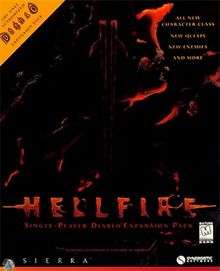Diablo: Hellfire
| Diablo: Hellfire | |
|---|---|
 Front cover artwork | |
| Developer(s) | Synergistic Software |
| Publisher(s) | Sierra On-Line |
| Designer(s) |
Kirt Lemons Donald Tsang Peter Watje Jim Edwards Mike McMillen |
| Programmer(s) | Donald Tsang |
| Writer(s) | Eve Forward |
| Series | Diablo |
| Platform(s) | Microsoft Windows |
| Release | |
| Genre(s) | Action role-playing, hack and slash |
| Mode(s) | Single-player, multiplayer |
Diablo: Hellfire is the expansion pack for the video game Diablo, developed by Synergistic Software, a Sierra division, and published by Sierra On-Line in 1997. Hellfire was re-released alongside Diablo in 1998 in a bundle called Diablo + Hellfire.
Overview
Hellfire is a single-player expansion to Diablo. While there are some multi-player modes that can be unlocked, Hellfire is not playable on Blizzard's online gaming service Battle.net, and its changes do not transfer to online characters. However, the expansion does offer many new features as a single-player game, and also does not interfere with a user's ability to still play Diablo with Blizzard's service.
Hellfire's storyline occurs as an aside to the main story arc of the original game. A sorcerer, while performing a ritual, unknowingly releases the demon Na-Krul unto the town of Tristram, but before it can completely escape, the sorcerer magically seals the doors. The player is later tasked with venturing into Na-Krul's lair and vanquishing it.
The expansion pack adds several enhancements to Diablo, including an additional monk class, two new dungeon settings, additional quests to undertake, several extra game items, including oils which affect item statistics, runes that can be placed as traps, a new page of spells, new affixes for weapons and armor, new shrines, new mini-boss enemy names, a noticeable boost to Diablo's strength and power, and a number of interface improvements.
Hellfire integrates into Diablo, and because of its design, its dungeons can be avoided entirely. In order to gain access to the dungeons, the player must speak with Lester the Farmer, who is north of Tristram, near the herd of cows; however, if the player speaks to Lester before reaching a certain point of the main Diablo quest, he will be hesitant to ask them to enter the new dungeons.
The rest of the expansion integrates more fully into the main adventure. Objects like oils, new weapons, rings and armor, and runes drop amid other more common kinds of items, and the new spellbooks, including books for two previously existing spells that did not have books, and scrolls are found in the same kinds of places. New shrines are found where shrines would normally be found. The new unique monsters, which appear as palette-swapped, but otherwise normal monsters with a unique name, also appear in the Diablo quest like any other; however, there are almost no unique monsters found within Hellfire's exclusive dungeons. Hellfire’s dungeons are populated with new enemies that do not appear in the main Diablo quest, while the difficulty of Hellfire dungeon floors 1-8 mirror those of levels 9-16 of the main Diablo quest, requiring experienced characters to explore.
Some of the newer convenience features include the option to move more quickly around town using the "jog" toggle found in the options menu, a spell that highlights objects lying on the floor as though the cursor was placed over them, and a spell that teleports the player to the nearest staircase found on that level of the dungeon.
Reception
| Reception | ||||||||
|---|---|---|---|---|---|---|---|---|
| ||||||||
Hellfire was a finalist for Computer Gaming World's 1998 "Best Add-On" award, which ultimately went to StarCraft: Brood War.[3]
References
- ↑ Brenesal, Barry (February 9, 1998). "Hellfire". PC Games. Archived from the original on August 28, 1999.
- ↑ Yans, Cindy (January 16, 1998). "Hellfire". Computer Games Strategy Plus. Archived from the original on April 6, 2005.
- ↑ Staff (April 1999). "Computer Gaming World's 1999 Premier Awards; CGW Presents the Best Games of 1998". Computer Gaming World (177): 90, 93, 96–105.
External links
- Diablo: Hellfire at Curlie (based on DMOZ)